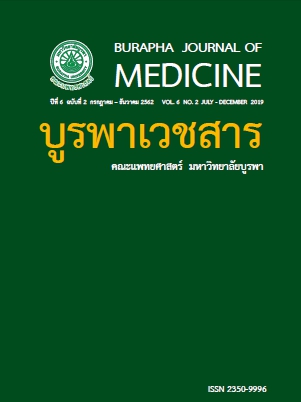การยอมรับและความพึงพอใจต่อตำรับขนมไทยสูตรลดไขมัน
คำสำคัญ:
ขนมไทย, ไขมัน, โภขนาการ, โรคไม่ติดต่อเรื่อรังบทคัดย่อ
วัตถุประสงค์ เพื่อพัฒนาตำรับขนมไทยสูตรลดไขมันที่ยอมรับต่ออาสาสมัคร
วิธีการศึกษา ตำรับขนมไทยจำนวน 3 รายการ (ขนมครก ขนมถ้วย กล้วยบวชชี) ได้รับเลือกจากการสำรวจ
และนำมาพัฒนารายการละ 3 สูตร ได้แก่ สูตรที่ใช้กะทิปกติ สูตรที่ใช้กะทิปกติกับกะทิธัญพืชอัตราส่วน 50:50
และสูตรที่ใช้กะทิธัญพืช ทำการทดสอบทางประสาทสัมผัสเพื่อทดสอบความพึงพอใจด้านต่างๆ ในอาสาสมัคร
จำนวน 30 คน
ผลการศึกษา ผลการศึกษาพบว่า คะแนนความพึงพอใจในด้านต่างๆ ของขนมไทยในแต่ละสูตรไม่มีความแตกต่าง
กันอย่างมีนัยสำคัญทางสถิติ ยกเว้นด้านกลิ่นขณะเคี้ยวของขนมครกและกล้วยบวชชีที่สูตรกะทิธัญพืชน้อยกว่า
สูตรอื่นอย่างมีนัยสำคัญทางสถิติ (p < 0.05) อย่างไรก็ตาม คะแนนความพึงพอใจโดยภาพรวมแต่ละสูตรของ
ทั้ง 3 รายการอยู่ในระดับที่อาสาสมัครให้การยอมรับ
สรุป ผลการศึกษาสามารถสรุปได้ว่าขนมไทยสูตรลดไขมันที่พัฒนาขึ้นทั้ง 3 รายการได้รับการยอมรับ
จากอาสาสมัคร
เอกสารอ้างอิง
K, Brown M, McPherson K. High rates of
obesity and non-communicable diseases
predicted across latin america. PLoS One.
2012; 7: e39589.
2. Chopra SM, Misra A, Gulati S, Gupta R.
Overweight, obesity and related noncommunicable
diseases in Asian Indian
girls and women. Eur J Clin Nutr. 2013;
67: 688-96.
3. Reba K, Argaw Z, Walle B, Gutema H.
Health-related quality of life of patients
with diagnosed type 2 diabetes in Felege
Hiwot Referral Hospital, North West
Ethiopia: a cross-sectional study. BMC Res
Notes. 2018; 11: 544.
4. Olawuyi AT, Adeoye IA. The prevalence and
associated factors of non-communicable
disease risk factors among civil servants
in Ibadan, Nigeria. PLoS One. 2018; 13:
e0203587.
5. Srivastav S, Mahajan H, Goel S,
Mukherjee S. Prevalence of risk factors
of noncommunicable diseases in a rural
population of district Gautam-Budh Nagar,
Uttar Pradesh using the World Health
Organization STEPS approach. J Family
Med Prim Care. 2017; 6: 491–7.
6. Aekplakorn W, Chariyalertsak S,
Kessomboon P, Assanangkornchai S,
Taneepanichskul S, Putwatana P.
Prevalence of diabetes and relationship
with socioeconomic status in the Thai
population: National Health Examination
Survey, 2004–2014. J Diabetes Res. 2018;
1; 2018: 1654530.
7. Jitnarin N, Kosulwat V, Rojroongwasinkul N,
Boonpraderm A, Haddock CK, Poston WSC.
Prevalence of overweight and obesity in
Thai population: results of the National
Thai Food Consumption Survey. Eat Weight
Disord. 2011; 16: 242–9.
8. Barnes AS. Obesity and sedentary lifestyles.
Risk for cardiovascular disease in women.
Tex Heart Inst J. 2012; 39: 224–7.
9. Raatz SK, Conrad Z, Johnson LK, Picklo
MJ, Jahns L. Relationship of the reported
intakes of fat and fatty acids to body
weight in US adults. Nutrients. 2017; 9: 438.
10. Banwell C, Dixon J, Seubsman S, Pangsap
S, Kelly M, Sleigh A. Evolving food retail
environments in Thailand and implications
for the health and nutrition transition.
Public Health Nutr. 2013; 16: 608–15.
11. Panda A, Ghosh K, Ray M, Nandi SK, Parua
(Mondal) S, Bera D, Singh SN, Dwivedi SK,
Mondal KC. Ethnic preparation and quality
assessment of Chhurpi, a home-made
cheese of Ladakh, India. J Ethni Foods.
2016; 3: 257-62.
12. Kim YJ, Kang S, Kim DH, Kim YJ, Kim WR,
Kim YM, Park S. Calorie reduction of
chocolate ganache through substitution
of whipped cream. J Ethni Foods. 2017;
4: 51-7.
13. Rueangsri N, Booranasuksakul U, Singhato
A. Development of snack recipes using
sucralose instead of sugar. Journal of
Nutrition Association of Thailand. 2018;
53: 13-24.
14. Mistry P, Stirling H, Callens C, Hodson
J, Batchelor H; SPaeDD-UK project.
Evaluation of patient-reported outcome
measurements as a reliable tool to
measure acceptability of the taste of
paediatric medicines in an inpatient
paediatric population. BMJ Open. 2018;
8: e021961.
15. Sapphanchang W, Wa-Ubon T, Nuket P,
Booranasuksakul U, Rueangsri N, Singhato
A. Development of low-sodium food
recipes according to tathuJaoruen belief:
semha element. Proceedings of the 1st
national graduate research conference
and creative innovation competition;
2017 August 17-18; the empress hotel,
Chiangmai. Chiangmai: Mae Jo University;
2017. 435-45.
16. Imsabai O. Thai desserts cooking
handbook. Sangdad publishing CO.,LTD.
2010; Bangkok.
17. Singh-Ackbarali D, Maharaj R. Sensory
evaluation as a tool in determining
acceptability of innovative products
developed by undergraduate students
in food science and technology at the
University of Trinidad and Tobago. Journal
of Curriculum and Teaching. 2014; 3: 10-
27.
18. Prasert W, Lowithun N, Phawsungthong U.
The development of reduced fat sandwich
spread from soy milk. Thai Agricultural
Research Journal. 2012; 30: 166-76.
19. Saksomboon K, Theprugsa P. Development
of Thai chicken sausage (Kai Yo) by
substituting chicken fat with frozen
rice bran oil. Journal of Science and
Technology. 2015; 23: 797-804.
20. Bayarri S, Taylor AJ, Hort J. The role of fat
in flavor perception: effect of partition and
viscosity in model emulsions. J Agric Food
Chem. 2006; 54: 8862–8.
21. Bolhuis DP, Newman LP, Keast RSJ. Effects
of salt and fat combinations on taste
preference and perception. Chem Senses.
2016; 41: 189–95.
22. Martin B, Golden E, Egan JM, Mattson MP,
Maudsley S. Reduced energy intake: the
secret to a long and healthy life? IBS J Sci.
2007; 2: 35–9.
23. Stroebele N, de Castro JM, Stuht J,
Catenacci V, Wyatt HR, Hill JO. A smallchanges
approach reduces energy intake
in free-living humans. J Am Coll Nutr. 2009;
28: 63–8.
24. Kelishadi R, Pour MH, Zadegan NS, Kahbazi
M, Sadry G, Amani A, Ansari R, Alikhassy H,
Bashardoust N. Dietary fat intake and lipid
profiles of Iranian adolescents: Isfahan
Healthy Heart Program--Heart Health
Promotion from Childhood. Prev Med.
2004 ; 39: 760-6.
25. Chan-o-Cha P. Thailand’s commitment
to global cooperation on NCDs: acting
together now. Lancet. 2019; 393(10166):
11-13.
26. Rippe JM, Angelopoulos TJ. Relationship
between Added Sugars Consumption
and Chronic Disease Risk Factors: Current
Understanding. Nutrients. 2016; 8: E697.



